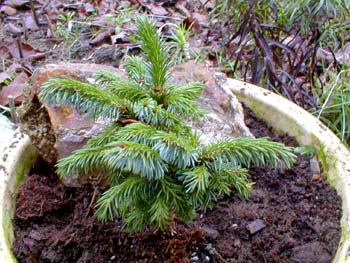
'Pimoko' Dwarf Serbian Spruce
"Never say there is nothing beautiful in the world any more. There is always something to make you wonder, in the shape of a leaf, the trembling of a tree."
-Albert Schweitzer
(1875-1965)
(1875-1965)
'Pimoko,' introduced in 1980, is among the smallest of the dwarf forms of Picea omorika, Serbian Spruce. The species is one of those trees loved by growers who are hoping to produce brand new cultivars. The sports of Serbian Spruce are seemingly unlimited in their range of shape, color, & size.
From fossilized remains it is known that the wild tree was once common throughout Europe. Pleistocene glaciers stripped it from the landscape so that it survived only in a restricted area of southeastern Europe's Balkans, within western Serbia & eastern Bosnia. The species was formerly milled for lumber, but because of their rarity, the few remaining wild stands are protected. The World Conservation Monitoring Centre estimates that fewer than 1,000 of the trees remain in the Pancic Narodni Nature Reserve in the Tara Mountains.
The wild tree is large & upright to sixty feet, but such dwarf forms as 'Pimoko' grow only about an inch & a half a year, forming a foot high, sixteen inch wide domed mound in ten years. As a bonsai with limited resources for its roots & expert pruning, it can remain even smaller. The species has additionally provided weeping forms, skinny upright forms, wide conical forms, prostrate forms, & varieties that are curiously irregular.
The species will always survive as even if its few remaining wild stands are someday lost to forest fire or poachers or disease, the cultivated forms will remain preferred ornamentals that do well even in poor soil & do well at busy roadsides, little phased by air pollution.
Tiny 'Pimoko' originated as a witch's broom. A witch's broom can get started on a tree's limb at the point of parasitic attack, such as at a point where mistletoe or gall mites infest a tree. Typically a parasite imitates a tree's growth-hormones in order to trick the tree into feeding it sugars. The combination of artificial growth hormone from the parasite & building-block sugars from the tree can induces a miniature of the tree to grow at the site of the parasitic injury or swollen gall.
Just such a witch's broom was saved from a Serbian Spruce for development as a garden cultivar by A. Wuestemeyer of Germany. Several such dwarfed trees have originated in this manner including the named varieties 'Loggerhead' dwarf Douglas Fir, 'Little Gem' Vine Maple, or 'Broom' Jack Pine.
'Pimoko' is usually grown as a small front-border rockery shrublet for year-round presence, as it forms a tidy perfect dome a bit wider than it is tall & no trunk visible. But trained as a bonzai it can be limited in its sideways spread & given more of the look of a stubby spruce tree in miniature, with a pleasing trunk bared, looking age-weathered & ancient despite its wee size.
The spruce needles are themselves miniatures at only one-fourth inch length, densely compact. The needles are grey-green to dark blue-green, having silvery-white stomotal bands. It can make quite a startling contrast alongside a regular dark green or a yellow-green dwarf conifer.
It wants rich humusy soil, moist with perfect drainage, & lots of sun, though it can sunburn in particularly lengthy hot days, or windburn in exposed locations during winter.
Our 'Pimoko' sat in its nursery pot for over a year, during which time it did not grow even the one-inch that is average. I finally got round to putting it in a nice container of good soil. Asa container shrub it gives a strong bonsai impression, but I will not be restricting the roots in any way, but will instead permit it to grow in whatever manner it wants to.